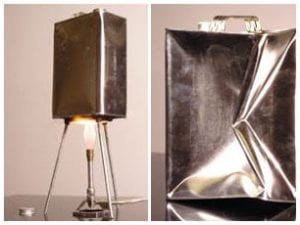Equipment:
- Gallon can with screw top
- Bunsen burner(with sparker) and ring stand or electric hot plate (if no gas line)
- Hot mitt
- Water
- Ice water bath (optional but recommended)
Demo:
Boil a small amount of water in the open can. When water vapor displaces most of the air, indicated by the presence of steam, remove the can from the heat and cap it. After placing in an ice bath or leaving to sit, the can will collapse in a couple of minutes.
Explanation:
When the can is taken off the heat and capped the water vapor will condense back into water as it cools. The can is malleable enough to be crushed by the pressure difference between the inside of the can (low pressure) and the outside of the can (high pressure). We can use the ideal gas law to describe this interaction,
where P is the pressure inside the can, V is the volume of the can, and T is the temperature of the gas. We can see that a decrease in temperature will result in a decrease in pressure. By placing the can in an ice bath, this effect is accelerated and results in a more dramatic demonstration.
Stellar Collapse:
The collapsing can demonstrates how stars collapse when they lose hydrostatic equilibrium (the balance between the thermal pressures from the heat source pushing outwards and gravity trying to make the star collapse to the very center). In stars, nuclear fusion generates outward thermal pressure that counteracts inward gravitational pressure. This balance stabilizes the star’s structure, just like the pressure caused by the steam inside the can balances the atmospheric pressure outside.
When a star exhausts its nuclear fuel, fusion stops, and thermal pressure drops. Similarly, cooling the can reduces internal pressure as vapor condenses. Without sufficient outward pressure, its own gravity draws matter inward toward the center of gravity, causing stellar collapse. This is analogous to when there is no pressure inside the can, the outside air pressure causes the can to implode.
Notes:
- Allow plenty of time for the can to heat up, especially if using a hot plate.
- Use caution when caping the can.
- An ice bath accelerates condensation for a quicker, more dramatic collapse.
Written by Lydia Seymour
